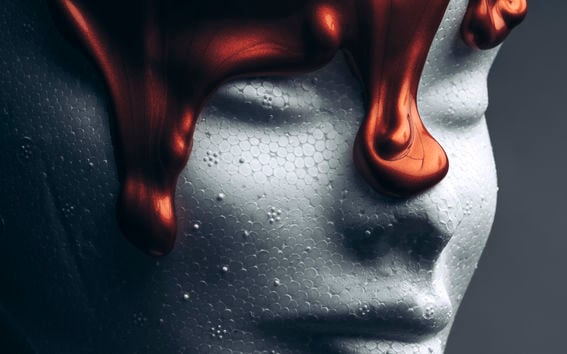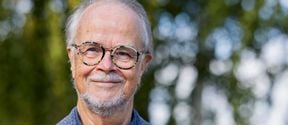AI’s story won’t be complete without art

A group of friends had maintained close contact, shared ideas and played role-playing video games in their parents’ basements since primary school. But their meetings became more infrequent once one of them began to study art and design, while others chose paths leading to cognitive science and electrical engineering.
‘When we’d meet, an argument would always arise on the differences between science and art. Should we search for objective truths or subjective experiences? We could never reach a consensus, so, one evening, I came up with the idea of us creating art together,’ says artist, visual arts educator and doctoral student Kasperi Mäki-Reinikka.
And, thus, the ‘Brains on Art’ art collective was born. They decided to see where they’d arrive at by replacing dead-end arguments with the making of art using the skills and means available to students of art, cognitive science and computer science. Their first exhibition piece was completed in 2013.
At the same time, Mäki-Reinikka’s master’s thesis sketched out the negotiative and contrast-seeking method of working created in the collective. Studies in the Art and Technology minor programme in the newly-founded Aalto University only spurred him on.
‘Our artistic activities are entirely based on the friction between different fields. In spite of the tension, or perhaps thanks to it, we create works that are both artistically interesting as well
as scientifically and technologically challenging.’
Brains on Art has created poems based on recordings of the electroencephalographic patterns of viewers as well as a performance art piece where a performer sways from side to side in tune with the fluctuations of the Helsinki Stock Exchange.
Reaching across fields
Mäki-Reinikka is currently a doctoral student at the Department of Art. His research explores fresh working practices that connect art and science.
‘Putting it bluntly, I’m studying how tech students and art students put in the same room can succeed in creating art together. I’m examining what they should know about each other’s fields and what kind of debate would enable the creation of new and artistically interesting works.’
In addition to the perspective of a media artist, Mäki-Reinikka’s research takes advantage of his teaching work in Aalto’s University-wide Art Studies programme, which encourages students in tech, business and art to engage in shared art projects. As art content coordinator of Aalto University Junior, he steers schoolchildren towards phenomenon-based learning. Mäki-Reinikka also participates as an artist member in the advisory working group of the Finnish Center for Artificial Intelligence (FCAI) initiated by Aalto University, University of Helsinki and VTT.
‘AI affects society as a whole. I’m delighted that FCAI wants to introduce the perspectives of all fields, art included, into the technical development of AI.’
New aesthetics through AI
AI is associated with moral and ethical questions that art is especially suited to consider.
‘Artists have always been quick to adopt new techniques, such as photography, video and the Internet, to employ in novel ways. Art can equally well introduce fresh openings for developing AI and machine learning. Could machines, for example, produce aesthetics of an entirely new kind?’
AI is also hard to pin down, Mäki-Reinikka notes.
‘Today’s smart phones would have been considered AIs 50 years ago. Be that as it may, the future will always bring forth new instruments for artists to work with.’
The most interesting projects are often those that can be approached from several viewpoints. Art can introduce something to the development of AI that would otherwise be missed. There is
an increasing need for dialogue across fields.
‘Dialogue, which spans different worldviews and concepts of knowledge, is not a threat to each party’s own value foundation and understanding of the world. Getting a peek of the other side is in and of itself valuable and necessary.’
Threat to humanity?
The boundary between the biological and the technological is narrowing as bio- and nanotechnology and cognitive science develop. Our sensory world is expanding through virtual and augmented reality as well as via devices creeping under our skin. When humans and machines begin to form something new, it is pertinent to ask how a machine can understand what constitutes art or an aesthetic experience.
‘New technologies carry great cultural significance regarding what, in future, it will mean to be human and what is humanity’s place in the world. Considerations of this magnitude cannot be left to one field alone. Art plays an important role in the adoption of new technologies.’
Brains on Art is good proof of how collisions between art and technology can give birth to something completely unique. In a multidisciplinary community, no one gets off easy when solving strange problems that might never be encountered alone. Art also provides a free space for experimentation.
‘In an art project, tech students and engineers get to experiment and play with their own specialised knowledge and skills in an entirely different way than would be possible in an experimental laboratory.’
Machine meets art
Right now, the Brains on Art collective is pondering how machines will meet art. It’s possible that they’ll find that machines are really dumb, incapable of understanding art. Or maybe not. What if machines do become capable of both creating and sensing art? Would this deprive artists of their work—and what’s the need for human viewers, then?
The collective is working on an machine learning image-recognition system, which uses tens of thousands of pictures provided by the Finnish National Gallery’s archive as raw material. What will happen when the machine viewer starts to classify and assign value to the pictures according to its own logic?
‘The usual approach is to supply similar images from within a specific genre of art, but we instead keep the experiencing machine in a loose leash and feed it with new works at certain intervals. The end result might start veering in unexpected directions.’
In the future, the Aalto campus may very well witness a work that introduces us to a new, aesthetic machine experience. The precise manner in which the piece will be presented remains open.
‘It could be an AI installation, which produces and experiences art in a specific space, or a portable creature you take with you to the gallery to look at art.’
Get inspired, experiment and make it real
- Look for opportunities for combining art and science. Check out workshops, follow research and propose a project.
- Look at art and make it yourself – Aalto offers excellent courses on art-based thinking.
- Challenge, be critical. There’s no need to agree on everything. Interdisciplinary friction can be transformed into a creative force.
- Remember: no field is monolithic. Art and science are created by people who come from many different backgrounds and think in many different ways.
Text: Marjukka Puolakka
This article has been lightly modified from the original published in Aalto University Magazine issue 23 (issuu.com), October 2018.
- Published:
- Updated:
Read more news

Aalto ARTS alum Vidha Samya’s artwork featured at the Venice Biennale 2024
The Pavilion of Finland presents ‘The pleasures we choose’ at the 60th International Art Exhibition – La Biennale di Venezia until 24 November 2024.
IoT Forge donates EUR 1 million to the School of Engineering
The donation will be used for research and education on the Industrial Internet and digital twins.
Join us for the first Aalto Open Science Award Ceremony
All Aaltonians are welcome – no registration required!